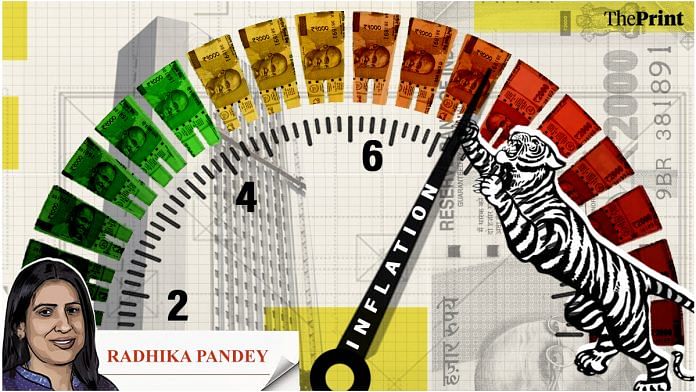The Monetary Policy Committee (MPC) of the Reserve Bank of India (RBI) Wednesday unanimously raised the policy repo rate by 50 basis points in order to rein in inflation, which has been running above its upper tolerance level since the beginning of this year. The committee sharply raised its projection for inflation for the current year from 5.7 per cent to 6.7 per cent, while retaining the projection for growth at 7.2 per cent.
The RBI rightly noted that preserving price stability and anchoring inflationary expectations is the optimal strategy to ensure durable growth. The policy statement gives a clear signal to the market that more policy rate hikes to tame inflation can be expected.
Shift in guidance amid intensification of inflationary pressures
The RBI acknowledged that inflationary pressures have intensified and have become more broad-based. There is a greater pass-through of input costs to product prices. In addition to goods inflation, services inflation is also picking up. The recent spike in tomato prices, revisions in electricity tariffs, and elevated commodity prices are also adding to the inflationary pressures.
Spillovers from global developments are still unfolding. The price of crude oil, after showing signs of easing, has again inched up to $120 per barrel. While the UN Food and Agriculture Organization’s (FAO) Food Price Index moderated in May, the cereal price index sub-component continued to escalate. The RBI noted that inflation will likely fall below the upper threshold of 6 per cent only by the end of the year. The RBI has projected inflation to decline from 7.4 per cent in the July-September quarter to 6.2 percent in the October-December quarter, and further to 5.8 percent in the January-March quarter. If inflationary pressures accentuate, there could be revisions to the inflation projections for the second half of the year.
The policy shift towards placing priority on managing inflation is reflected in the guidance statement. Till February, the RBI’s focus was on reviving and sustaining growth. In the April policy, the RBI spoke about withdrawal of accommodation while remaining accommodative. This stance was retained in the May policy review. In the June policy, the MPC statement has dropped its `commitment to remain accommodative’. The focus is now on ‘withdrawal of accommodation’ to ensure that inflation remains within the target. The shift in the policy statement gives clarity to markets that the RBI will not hesitate to raise rates further to tame inflation.
Also read: The world faces a stagflation risk but India might just escape it
Growth remains steady but needs to be watched
On the positive front, while inflation has risen faster than anticipated, growth has remained resilient. In addition to the various high-frequency indicators — such as the Purchasing Managers’ Index (PMI) for manufacturing, PMI for services, core sector growth, and improvements in auto sales that point to steady growth — capacity utilisation has increased from 72 per cent to more than 74 percent in the January-March quarter. The rise in capacity utilisation coupled with government’s capex push and the deleveraged balance-sheets of companies should improve the investment climate, going forward. Expectations of a normal south-west monsoon, and encouraging kharif sowing, also bode well for growth.
While the RBI doesn’t seem to be too worried about growth at the moment, concerns are emerging, as is evident from recent downward revisions in growth projections by some agencies. The World Bank has revised its GDP growth forecast for India for the current year from 8 per cent to 7.5 per cent owing to inflationary pressures, supply-side disruptions and geopolitical tensions. To be sure, India is not alone in facing a weaker growth projection. The forecast for global growth has also been revised downwards from 4.1 per cent to 2.9 per cent.
Transmission of rate hikes to loans and deposits
Two consecutive rate hikes will lead to an upward adjustment of lending rates by banks. Since most of the loans given to the retail segment and to micro, small and medium enterprises are linked to external benchmarks, a hike in policy repo rate rates leads to a faster transmission to lending rates. After the 4 May policy rate hike, many banks hiked their lending rates across tenures. Lending rates will rise further after the recent 50-basis-point hike in the policy repo rate. But despite the increase in lending rates and customers’ equated monthly instalments (EMIs), bank credit witnessed double-digit growth of more than 11 per cent in the fortnight ending 20 May.
The increase in the repo rate will lead to an increase in the bank deposit rates, although the deposit rates are not in sync with the repo rate hike. But as credit offtake gains momentum, banks will have to hike deposit rates to garner resources for advancing loans.
Government borrowing and bond markets
Bond yields have been rising faster than anticipated this year. The fear of higher-than-budgeted borrowing due to recently announced duty cuts and subsidies is causing bond yields to inch up. This will make government borrowing costlier. While the RBI assured the markets on the orderly completion of the government borrowing programme, no measures were announced to directly intervene to manage government bond yields. This is a welcome step. The emphasis has been on withdrawing the surplus liquidity; hence, any move to cool yields through, say, open market operations (OMOs), would have complicated the stance of the RBI.
Radhika Pandey is a consultant at National Institute of Public Finance and Policy.
Views are personal.
Also read: Modi govt’s steps to fight inflation will help, but there’s a risk of unintended consequences



